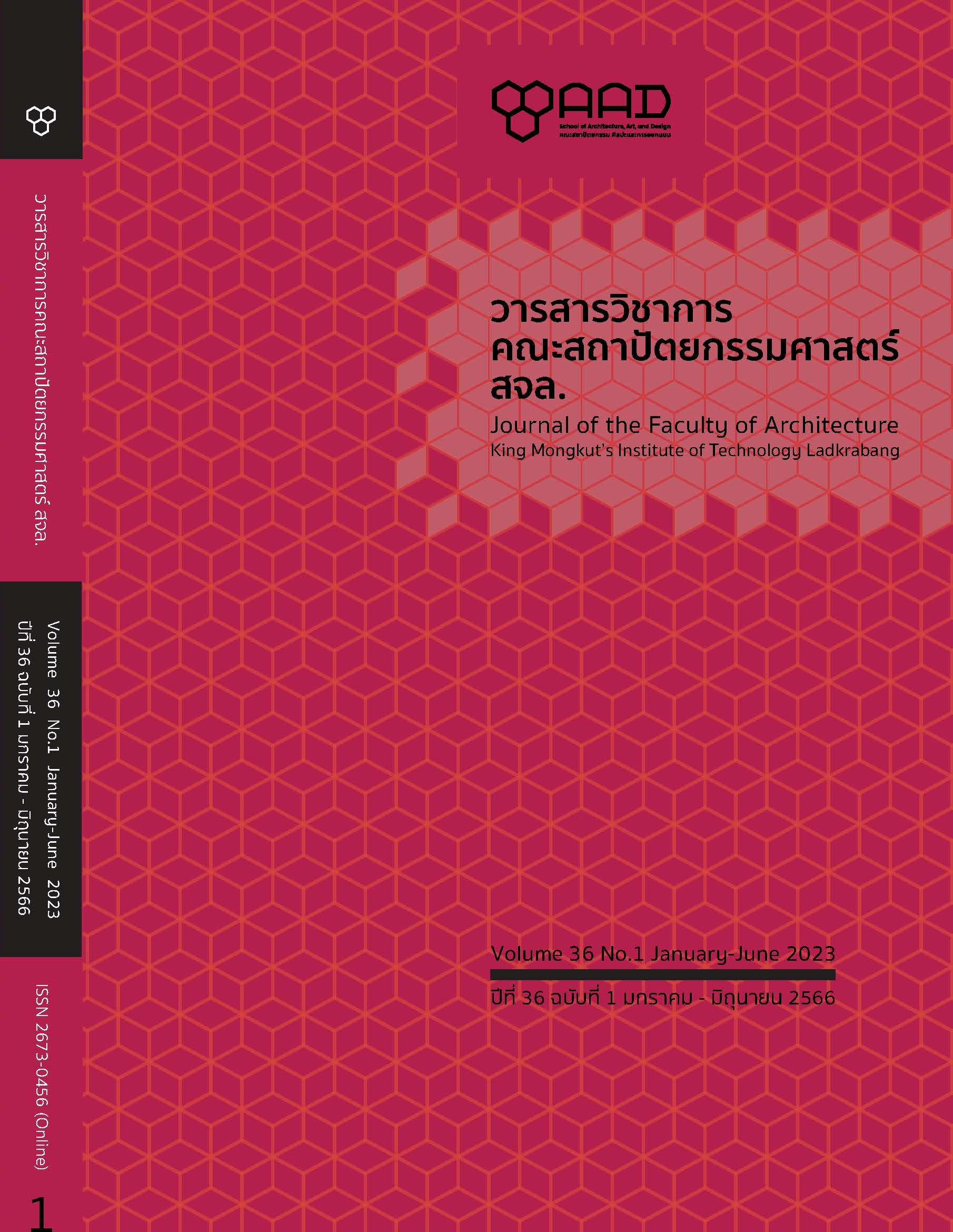The Visible Physical of SamKhok Water Jar, Pathum Thani
Main Article Content
Abstract
“Tum SamKhok” or SamKhok water jar is a household product of local wisdom from the Mon community who immigrated to settle along the banks of the Chao Phraya River in the early Ayutthaya period in SamKhok District, Pathum Thani Province. Making a living by molding and boating, selling unglazed earthenware. Khok means a mound with a hood-type kiln for firing earthenware. Three is the number. Sam Khok means sites with 3 kilns. Study, observe, interview and analyze data from documents, research papers, and actual site visits of 3 temples that have evidence of Tum SamKhok excavation, namely Wat Sing, Wat Sala Daeng Nuea, and Wat Pho Luan. The objective is to study, analyze and compare visible physical of SamKhok water jar, Pathum Thani. The visible physical is form and pattern of an unglazed earthenware with middle layer of Samkok clay that is tough, shrinks, absorbs water, thus retains coolness well. Clay when burned has a reddish-orange color. The size and proportion of the water jar is not high, the middle is rounded, starting from the base of the nostrils. Decorated with a pair of deep grooves at a slight distance from each other around the sloping and harmonious shoulder. The mouth of the water jar is small in diameter, similar to the bottom. There are 3 sizes of Samkhok water jar divided according to their usefulness: small, medium and large. Samkhok water jars are handicrafts made of 9 river soils or paddy fields mixed with 1-part fine brick and 1 part rice husk mixed together. It has been trampled until smooth before being molded and burned. Therefore, the shape and size will not be the same and all are just the closest to each other. Changing lifestyles have reduced the demand for this household product to the point of lack of inheritance. In addition, the Mon people migrated to Nonthaburi and Ratchaburi province, developing patterns, and manufacturing techniques into new water jars that were taller and less bulging.
Article Details

This work is licensed under a Creative Commons Attribution-NonCommercial-NoDerivatives 4.0 International License.
This work is licensed under a Creative Commons Attribution-NonCommercial-ShareAlike 4.0 International License.
Copyright Transfer Statement
The copyright of this article is transferred to Journal of The Faculty of Architecture King Mongkut's Institute of Technology Ladkrabang with effect if and when the article is accepted for publication. The copyright transfer covers the exclusive right to reproduce and distribute the article, including reprints, translations, photographic reproductions, electronic form (offline, online) or any other reproductions of similar nature.
The author warrants that this contribution is original and that he/she has full power to make this grant. The author signs for and accepts responsibility for releasing this material on behalf of any and all co-authors.
References
กนกนาฏ พรหมนคร. (2562). การศึกษาและพัฒนารูปแบบผลิตภัณฑ์หัตถกรรมเครื่องปั้นดินเผาจากดินสามโคก จังหวัดปทุมธานี เพื่อประยุกต์ใช้ในการออกแบบผลิตภัณฑ์ของที่ระลึก. วารสารวิจิตรศิลป์. 10(1), 26-47.
ดวงจันทร์ นาชัยสินธุ์. (2562). การพัฒนาผลิตภัณฑ์ด้วยทุนทางวัฒนธรรม ชุมชนวิถีบวก กลุ่มทอเสื่อบ้านท่อนใหม่ อำเภอเมืองขอนแก่น จังหวัดขอนแก่น. วารสารศิลปกรรมศาสตร์. 11(2), 285-304.
นิพัทธ์พร เพ็งแก้ว. (2539). สามโคก: บนเส้นทางอดีตและจินตนาการของวันวาน. วารสารเมืองโบราณ. 22(2), 144.
พนมศักดิ์ สุวิสุทธิ์. (2561). การวิจัยเครื่องปั้นดินเผาพื้นบ้านแนวแม่น้ำเจ้าพระยา. วารสารศิลปกรรมศาสตร์. 22(2), 98-114.
เหมือนพิมพ์ สุวรรณกาศ. (2558). รายงานการวิจัยเรื่องมรดกทางวัฒนธรรม: การสร้างตัวตนคนมอญสามโคก จังหวัดปทุมธานี. ปทุมธานี: โครงการวิจัยเพื่อรับทุนวิจัยคณะสังคมวิทยาและมานุษยวิทยา ประจำปีงบประมาณ 2558 มหาวิทยาลัยธรรมศาสตร์.
รามัญคดี-มอญศึกษา. (2557). “สามโคก-บริเวณที่มีโคกหลาย...ไม่ใช่โคกสาม” เข้าถึงได้จาก: https://th-th.facebook.com/RamannMon
วารดา พุ่มผกา. (2560). ภูมิปัญญาด้านศิลปกรรมของชุมชนไทยเชื้อสายมอญเพื่อออกแบบสื่อการเรียนรู้. (ดุษฎีนิพนธ์หลักสูตรปรัชญาดุษฎีบัณฑิต คณะศิลปกรรมศาสตร์, มหาวิทยาลัยบูรพา).
วัชระ สิงห์โตทอง และคณะ. (2563). แผนการใช้ที่ดินระดับตำบล (พ.ศ. 2563-2566) ตำบลบางเตย อำเภอสามโคก จังหวัดปทุมธานี. ปทุมธานี: สถานพัฒนาที่ดินปทุมธานี สำนักงานพัฒนาที่ดินเขต 1 กรมพัฒนาที่ดิน.
สำนักงานประชาสัมพันธ์จังหวัดปทุมธานี. (2558). ที่นี่จังหวัดปทุมธานี. เข้าถึงได้จาก: http://www.rangsitcity.com/pubrelnews/จปทุมธานี-พบตุ่มสามโคกโบราณฝังใต้ฐานโบสถ์วัดโพธ์เลื่อน-อายุกว่า-200-ปี
สำนักงานพัฒนาวิทยาศาสตร์และเทคโนโลยีแห่งชาติ. (2565). โบราณสถานเตาโอ่งอ่าง. เข้าถึงได้จาก: https://www.thailibrary.in.th/2021/03/16/archaeological-samkhok
สำนักงานวัฒนธรรมจังหวัดปทุมธานี. (2565). ตุ่มสามโคก. เข้าถึงได้จาก: https://www.m-culture.go.th/phatumthani/ewt_news.php
สราวุฒิ วงษ์เนตร และอภิศักดิ์ วัฒิวรรณผล. (2556). การพัฒนาเนื้อดินพื้นบ้าน ตำบลสามโคก จังหวัดปทุมธานี สำหรับงานประติมากรรมดินเผาไทย. กรุงเทพฯ: มหาวิทยาลัยเทคโนโลยีราชมงคลรัตนโกสินทร์ วิทยาลัยเพาะช่าง.
อนันต์ คติยะจันทร์, พระสมุห์กฤติพิสิฐ จ่าพันธ์ และพระสุวรรณ์ ปูนอ่อน. (2564). การพัฒนาทุนทางวัฒนธรรมโดยชุมชนเป็นรากฐานในพื้นที่ชายแดนไทย จังหวัดหนองคาย. วารสารมหาจุฬานาครทรรศน์. 8(1), 188-200.
Crotts, J. (2005). Craftsmen. Pennsylvania: Shepherd Press.
Jiang, L. (2012). The Importance of Craftsmanship: The case of Chinese Ceramics. In McClelland D. C. (Ed.), Proceeding of Association for Cultural Economics International. (pp. 1953). Kyoto, Japan: Association for Cultural Economics International.


